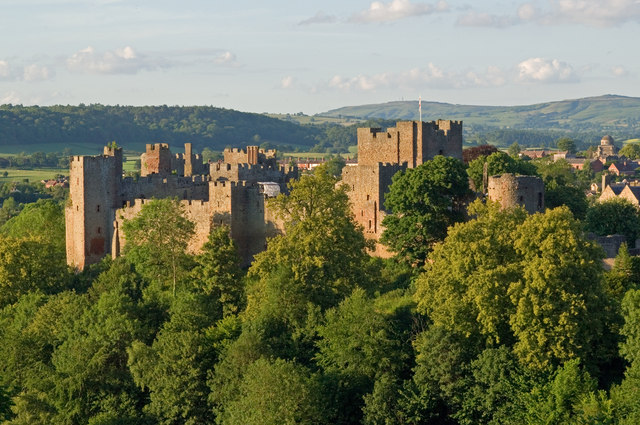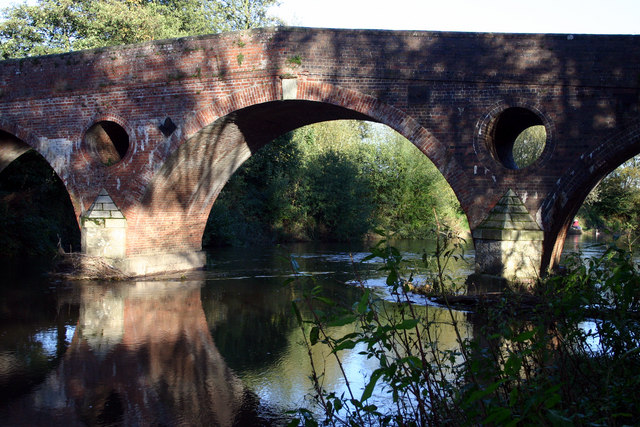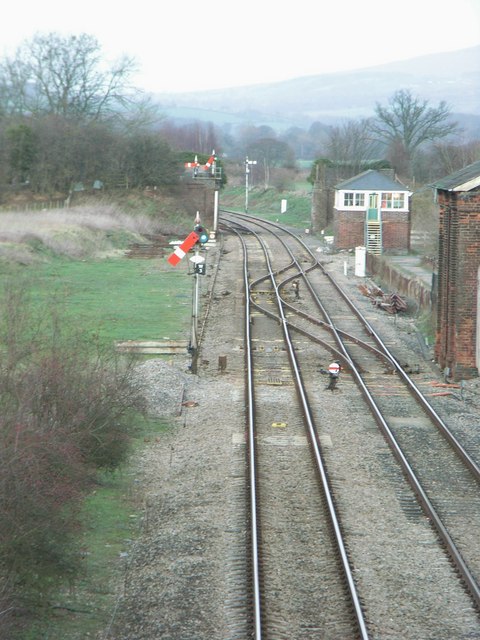|
Shrewsbury And Hereford Railway
The Shrewsbury and Hereford Railway was an English railway company that built a standard gauge line between those places. It opened its main line in 1853. Its natural ally seemed to be the Great Western Railway. With other lines it formed a route between the mineral resources of South Wales and the industries of the north-west of England, and this attracted the interest of the London and North Western Railway, which sought access to South Wales. The GWR and the LNWR jointly leased the S&HR line in 1862, later jointly acquiring ownership of it, in 1871. LNWR mineral traffic developed, and after the opening of the Severn Tunnel in 1886, the line became an important main line for traffic from the south-west of England to the north-west. With the decline in local passenger and goods traffic in the 1950s many intermediate stations closed, but the main line continues in important use at the present day. Origins On 3 August 1846, 16 railway bills were passed in Parliament; one of th ... [...More Info...] [...Related Items...] OR: [Wikipedia] [Google] [Baidu] |
Great Western Railway
The Great Western Railway (GWR) was a British railway company that linked London with the southwest, west and West Midlands of England and most of Wales. It was founded in 1833, received its enabling Act of Parliament on 31 August 1835 and ran its first trains in 1838 with the initial route completed between London and Bristol in 1841. It was engineered by Isambard Kingdom Brunel, who chose a broad gauge of —later slightly widened to —but, from 1854, a series of amalgamations saw it also operate standard-gauge trains; the last broad-gauge services were operated in 1892. The GWR was the only company to keep its identity through the Railways Act 1921, which amalgamated it with the remaining independent railways within its territory, and it was finally merged at the end of 1947 when it was nationalised and became the Western Region of British Railways. The GWR was called by some "God's Wonderful Railway" and by others the "Great Way Round" but it was famed as the "Holiday ... [...More Info...] [...Related Items...] OR: [Wikipedia] [Google] [Baidu] |
Leominster Railway Station Geograph-2900303-by-Ben-Brooksbank
Leominster ( ) is a market town in Herefordshire, England, at the confluence of the River Lugg and its tributary the River Kenwater. The town is north of Hereford and south of Ludlow in Shropshire. With a population of 11,700, Leominster is the largest of the five towns (Leominster, Ross-on-Wye, Ledbury, Bromyard and Kington) in the county. From 1974 to 1996, Leominster was the administrative centre for the former local government district of Leominster. Toponymy The town takes its name from the English word minster, meaning a community of clergy and the original Celtic name for the district ''Leon'' or ''Lene'', probably in turn from an Old Welsh root ''lei'' to flow. The Welsh name for Leominster is ''Llanllieni'', with Llan suggesting a possible Celtic origin to the town's religious community. Contrary to certain reports, the name has nothing to do with Leofric, an 11th-century Earl of Mercia (most famous for being the miserly husband of Lady Godiva). History Durin ... [...More Info...] [...Related Items...] OR: [Wikipedia] [Google] [Baidu] |
Ludlow
Ludlow () is a market town in Shropshire, England. The town is significant in the history of the Welsh Marches and in relation to Wales. It is located south of Shrewsbury and north of Hereford, on the A49 road which bypasses the town. The town is near the confluence of the rivers Corve and Teme. The oldest part is the medieval walled town, founded in the late 11th century after the Norman conquest of England. It is centred on a small hill which lies on the eastern bank of a bend of the River Teme. Situated on this hill are Ludlow Castle and the parish church, St Laurence's, the largest in the county. From there the streets slope downward to the rivers Corve and Teme, to the north and south respectively. The town is in a sheltered spot beneath Mortimer Forest and the Clee Hills, which are clearly visible from the town. Ludlow has nearly 500 listed buildings, including examples of medieval and Tudor-style half-timbered buildings. The town was described by Sir John Betjeman ... [...More Info...] [...Related Items...] OR: [Wikipedia] [Google] [Baidu] |
Tenbury Wells
Tenbury Wells (locally Tenbury) is a market town and Civil parishes in England, civil parish in the northwestern extremity of the Malvern Hills District of Worcestershire, England. Its northern border adjoins Shropshire, and at the 2011 census it had a population of 3,777. Geography Tenbury Wells lies on the south bank of the River Teme; the river forms the border between Shropshire and Worcestershire. The settlement of Burford, Shropshire, Burford in Shropshire lies on the north bank of the river. History From 1894 to 1974, it was a rural district, comprising the town itself and villages such as Stoke Bliss, Eastham, Worcestershire, Eastham and Rochford, Worcestershire, Rochford. From 1974 Tenbury was in the District of Leominster until it became part of Malvern Hills (district), Malvern Hills District when Leominster District Council was taken over by Herefordshire Council in April 1998. The history of Tenbury Wells extends as far back as the Iron Age. The town has been descr ... [...More Info...] [...Related Items...] OR: [Wikipedia] [Google] [Baidu] |
Woofferton
Woofferton is a village to the south of Ludlow, in Shropshire, England. It is one of Shropshire's most southerly villages and lies on the border with Herefordshire. It is part of the civil parish of Richard's Castle. The larger Herefordshire village of Brimfield is just over the border to the south. Transport Woofferton is at the crossroads of the A49 Ludlow-Leominster road (north-south), the A456 road that strikes eastwards and the B4362 (westwards). It was formerly the site of Woofferton railway station (on the Shrewsbury and Hereford Railway) and Woofferton Junction which served the (now closed) Tenbury & Bewdley Railway. The Welsh Marches Line runs through the currently closed station, with Transport for Wales running on the section without intermediate stations between Leominster and Ludlow. Places of interest It is best known for the Woofferton transmitting station (a notable feature of the area's landscape) and a Travelodge. The public house there - the "Salwey Arms ... [...More Info...] [...Related Items...] OR: [Wikipedia] [Google] [Baidu] |
Birmingham New Street Railway Station
Birmingham New Street is the largest and busiest of the three main railway stations in Birmingham city centre, England, and a central hub of the British railway system. It is a major destination for Avanti West Coast services from , and via the West Coast Main Line, the CrossCountry network, and for local and suburban services within the West Midlands; this includes those on the Cross-City Line between , and , and the Chase Line to and . The three-letter station code is BHM. The station is named after New Street, which runs parallel to the station, although the station has never had a direct entrance except via the Grand Central shopping centre. Historically, the main entrance to the station was on Stephenson Street, just off New Street. As of 2022, the station has entrances on Stephenson Street, Smallbrook Queensway, Hill Street and Navigation Street. New Street is the fifth busiest railway station in the UK and the busiest outside London, with 46.5 million passenger ... [...More Info...] [...Related Items...] OR: [Wikipedia] [Google] [Baidu] |
Beeching Axe
The Beeching cuts (also Beeching Axe) was a plan to increase the efficiency of the nationalised railway system in Great Britain. The plan was outlined in two reports: ''The Reshaping of British Railways'' (1963) and ''The Development of the Major Railway Trunk Routes'' (1965), written by Richard Beeching and published by the British Railways Board. The first report identified 2,363 stations and of railway line for closure, amounting to 55% of stations, 30% of route miles, and 67,700 British Rail positions, with an objective of stemming the large losses being incurred during a period of increasing competition from road transport and reducing the rail subsidies necessary to keep the network running. The second report identified a small number of major routes for significant investment. The 1963 report also recommended some less well-publicised changes, including a switch to the now-standard practice of containerisation for rail freight, and the replacement of some services wit ... [...More Info...] [...Related Items...] OR: [Wikipedia] [Google] [Baidu] |
Dinmore Tunnels , Herefordshire
{{disambig, geo ...
Dinmore may refer to: Places Australia *Dinmore, Queensland United Kingdom * Dinmore, Herefordshire *Dinmore Hill, Herefordshire *Dinmore Manor, Herefordshire * Dinmore Tunnel, Herefordshire *Hope under Dinmore Hope under Dinmore is a village and civil parish in Herefordshire, England. The village is on the A49 road, south of Leominster and north of Hereford, and on the Welsh Marches railway line. The railway passes under Dinmore Hill through the sp ... [...More Info...] [...Related Items...] OR: [Wikipedia] [Google] [Baidu] |
Woofferton Station (disused) - Geograph
Woofferton is a village to the south of Ludlow, in Shropshire, England. It is one of Shropshire's most southerly villages and lies on the border with Herefordshire. It is part of the civil parish of Richard's Castle. The larger Herefordshire village of Brimfield is just over the border to the south. Transport Woofferton is at the crossroads of the A49 Ludlow-Leominster road (north-south), the A456 road that strikes eastwards and the B4362 (westwards). It was formerly the site of Woofferton railway station (on the Shrewsbury and Hereford Railway) and Woofferton Junction which served the (now closed) Tenbury & Bewdley Railway. The Welsh Marches Line runs through the currently closed station, with Transport for Wales running on the section without intermediate stations between Leominster and Ludlow. Places of interest It is best known for the Woofferton transmitting station (a notable feature of the area's landscape) and a Travelodge. The public house there - the "Salwey Arms ... [...More Info...] [...Related Items...] OR: [Wikipedia] [Google] [Baidu] |
Oxford, Worcester And Wolverhampton Railway
The Oxford, Worcester and Wolverhampton Railway (OW&WR) was a railway company in England. It built a line from Wolvercot JunctionThe nearby settlement is spelt ''Wolvercote'' and a later station on the LNWR Bicester line follows that spelling. The OW&WR and GWR consistently used the spelling ''Wolvercot''. near Oxford to Worcester, Stourbridge, Dudley and Wolverhampton, as well as some branches. Its main line was opened in stages between 1852 and 1853. When the West Midland Railway (WMR) was formed by amalgamation in 1860, the OW&WR was the dominant partner, but the West Midland company amalgamated with the Great Western Railway (GWR) in 1863. Several branches and extensions were built in the West Midlands, and the main line was developed as an important trunk route. Much of the original main line is in use at present (2017). Before the OW&WR In 1841 the GWR opened its first main line between London and Bristol. It was engineered by Isambard Kingdom Brunel and the track was on ... [...More Info...] [...Related Items...] OR: [Wikipedia] [Google] [Baidu] |
West Midland Railway
The West Midland Railway was an early British railway company. It was formed on 1 July 1860 by a merger of several older railway companies and amalgamated with the Great Western Railway on 1 August 1863. It was the successor to the Oxford, Worcester and Wolverhampton Railway (OWWR). History Constituents The original constituent companies were the Newport, Abergavenny and Hereford Railway (incorporated 1846 and opened 1854), the Worcester and Hereford Railway (inc 1853 and opened 1859), and the Oxford, Worcester and Wolverhampton Railway (inc 1845 and opened 1850); which had already absorbed the Stratford and Moreton Tramway (inc 1821 and opened 1826). On 1 July 1861 the WMR leased the Coleford, Monmouth, Usk and Pontypool Railway (inc 1853 and opened 1857). In 1862 it also leased the Leominster and Kington Railway (opened 1857) and the Severn Valley Railway (from opening). Amalgamation with the GWR The West Midland Railway was dissolved on 1 August 1863, with its powers and ob ... [...More Info...] [...Related Items...] OR: [Wikipedia] [Google] [Baidu] |
Worcester, England
Worcester ( ) is a cathedral city in Worcestershire, England, of which it is the county town. It is south-west of Birmingham, north-west of London, north of Gloucester and north-east of Hereford. The population was 103,872 in the 2021 Census. The River Severn flanks the western side of the city centre. It is overlooked by Worcester Cathedral. Worcester is the home of Royal Worcester, Royal Worcester Porcelain, composer Edward Elgar, Lea & Perrins, makers of traditional Worcestershire sauce, the University of Worcester, and ''Berrow's Worcester Journal'', claimed as the world's oldest newspaper. The Battle of Worcester in 1651 was the final battle of the English Civil War, during which Oliver Cromwell's New Model Army defeated Charles II of England, King Charles II's Cavalier, Royalists. History Early history The trade route past Worcester, later part of the Roman roads in Britain, Roman Ryknild Street, dates from Neolithic times. It commanded a ford crossing over the Rive ... [...More Info...] [...Related Items...] OR: [Wikipedia] [Google] [Baidu] |




.jpg)


.jpg)
